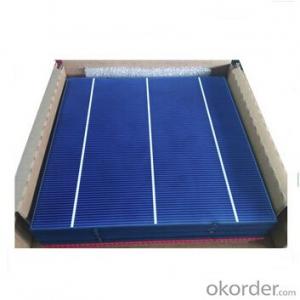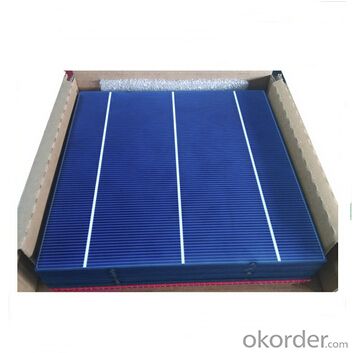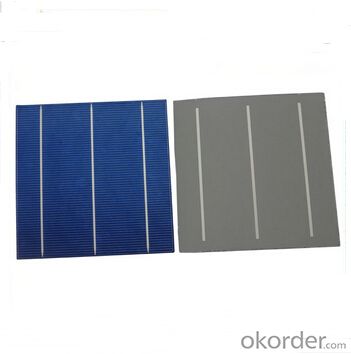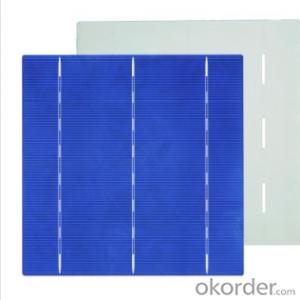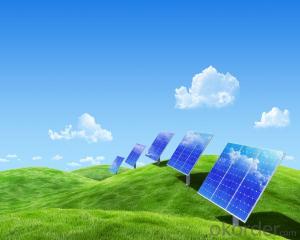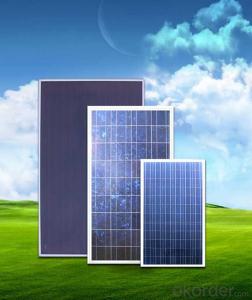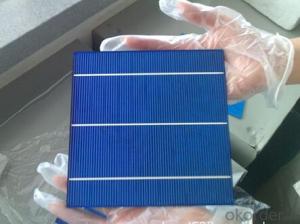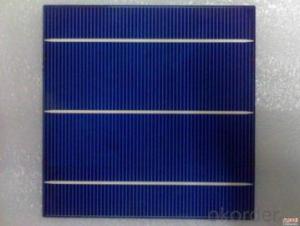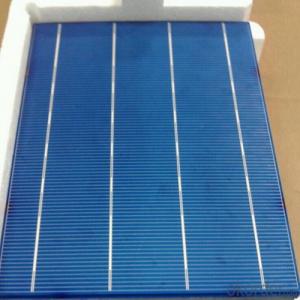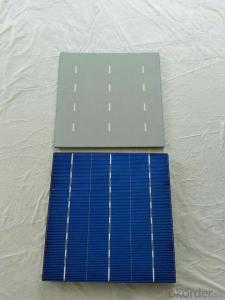2nd Generation Polycrystalline Silicon Solar Cell with 3 Bus Bars Alkaline
- Loading Port:
- Shanghai
- Payment Terms:
- TT OR LC
- Min Order Qty:
- 1000 pc
- Supply Capability:
- 1000000 pc/month
OKorder Service Pledge
OKorder Financial Service
You Might Also Like
PolyCrystalline Silicon Solar Cell 3 Bus Bars Alkaline:
Solar cells is made by solar wafer, it has three categories of solar cell right now, monocrystalline polycrystalline and thin film,These cells are entirely based around the concept PN junction, which is the critical part of solar module, it is the part that can convert the light energy into electricity, the thickness is from 180um to 200um, with even busbars to conduct electricity, textured cell can decrease diffuse reflection; they are often electrically connected and encapsulated as a module. Photovoltaic modules often have a sheet of glass on the front (sun up) side, allowing light to pass while protecting semiconductor wafers from abrasion and impact due to wind-driven debris, rain, hail, etc. Solar cells are also usually connected in series in modules, creating an additive voltage. Connecting cells in parallel will yield a higher current;With high quality and stable quality. Our Cells can greatly improve the performance of Solar Modules.
PolyCrystalline Silicon Solar Cell 3 Bus Bars Alkaline Advantage:
• High efficiency and stable performance in photovoltaic conversion.
• Advanced diffusion technique ensuring the homogeneity of energy conversion efficiency of the cell.
• Advanced PECVD film forming, providing a dark blue silicon nitride anti-reflection film of homogenous color and attractive appearance.
• High quality metal paste for back surface and electrode, ensuring good conductivity, high pulling strength and ease of soldering.
• High precision patterning using screen printing, ensuring accurate busbar location for ease with automatic soldering a laser cutting.
Specifications:
Efficiency code | 1640 | 1660 | 1680 | 1700 | 1720 |
Efficiency(min) (%) | 16.4 | 16.6 | 16.8 | 17.0 | 17.2 |
Pmax (W) | 3.991 | 4.040 | 4.088 | 4.137 | 4.186 |
Voc (V) | 0.621 | 0.622 | 0.623 | 0.625 | 0.627 |
Isc (A) | 8.203 | 8.267 | 8.335 | 8.398 | 8.454 |
Vmp (V) | 0.519 | 0.520 | 0.521 | 0.523 | 0.525 |
Imp (A) | 7.690 | 7.769 | 7.847 | 7.910 | 7.973 |
Packaging & Delivery of Polycrystalline Solar Cells
Carton Box Package and Deliver by air. It should be noticed that it should be avoid of water, sunshine and moist.
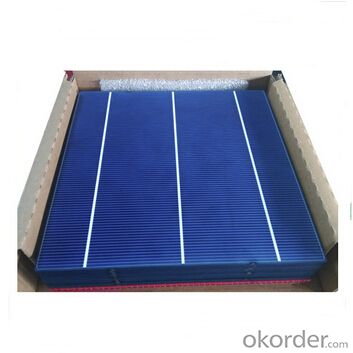
FAQ
We have organized several common questions for our clients,may help you sincerely:
①What price for each watt?
It depends on the efficiency of the solar cell, quantity, delivery date and payment terms.
②How long can we receive the product after purchase?
In the purchase of product within three working days, We will arrange the factory delivery as soon as possible. The pecific time of receiving is related to the state and position of customers.Commonly 7 to 10 working days can be served.
③Can you provide the peripheral products of the solar panels, such as the battery, controller, and inverter? If so, can you tell me how do they match each other?
Yes, we can, we have two companies for solar region, one is CNBM International, the other is CNBM engineering Co.
We can provide you not only the solar module but also the off grid solar system, we can also provide you service with on grid plant.
④What is your warranty of solar cell?
Our product can promise lower than 0.3% open box crack, we support claim after opening the box if it has crackm color difference or sth, the buyer should give pictures immediately, we can not accept the claim after the solar cell has assembled to solar panel.
• Timeliness of delivery
• ⑤How do you pack your products?
We have rich experience on how to pack the solar cell to make sure the safety on shipment, we could use wooden box or pallet as buyer's preference.
⑥ Can you do OEM for us?
Yes, we can.
- Q: How long is the long cycle solar cell life?
- Various solar cells according to its working principle, life is different (1) silicon solar cells Silicon solar cells are divided into three kinds of monocrystalline silicon solar cells, polycrystalline silicon thin film solar cells and amorphous silicon thin film solar cells.
- Q: What is the difference between polysilicon and monocrystalline silicon photovoltaic cells?
- Monocrystalline silicon is made of polycrystalline silicon by a single crystal furnace, but also useful for the preparation of monocrystalline silicon melting. Polysilicon is the direct raw material for the production of monocrystalline silicon, which is the basic material of electronic information for semiconductor devices such as contemporary artificial intelligence, automatic control, information processing, photoelectric conversion and so on. Known as the "cornerstone of the microelectronics building."
- Q: Can solar cells be used in schools or educational institutions?
- Yes, solar cells can definitely be used in schools or educational institutions. Installing solar panels in schools not only helps in reducing electricity costs but also provides an opportunity to educate students about renewable energy sources and sustainability. It allows schools to become more environmentally conscious by reducing their carbon footprint and serves as a great educational tool to teach students about solar energy and its benefits.
- Q: How do solar cells impact air pollution?
- Solar cells have a significant positive impact on air pollution as they produce clean and renewable energy. By harnessing the power of the sun, solar cells reduce the need for fossil fuel combustion, which is a major source of air pollution. This means that the use of solar cells helps to decrease harmful emissions such as carbon dioxide, sulfur dioxide, and nitrogen oxides, leading to cleaner and healthier air.
- Q: Can solar cells be used in water?
- Yes, solar cells can be used in water. Some solar panels are specifically designed to be used in water environments, such as floating solar panels used in reservoirs, lakes, and other bodies of water. These panels are waterproof and can efficiently generate electricity even when partially submerged.
- Q: What are the environmental impacts of solar cell production?
- The environmental impacts of solar cell production include the extraction of raw materials, such as silicon, which can contribute to deforestation and habitat destruction. The manufacturing process also requires a significant amount of energy, which may be sourced from fossil fuels and contribute to greenhouse gas emissions. Additionally, the disposal and recycling of solar panels can pose challenges, as some components contain harmful substances. However, it is important to note that the overall environmental benefits of solar energy, such as reduced greenhouse gas emissions and reliance on fossil fuels, outweigh these impacts.
- Q: Can solar cells work in cloudy weather?
- Yes, solar cells can still work in cloudy weather, although their efficiency may be reduced. Clouds diffuse sunlight, causing a decrease in the amount of direct sunlight reaching the solar cells. However, solar cells can still generate electricity from the diffused sunlight, although at a lower rate compared to sunny conditions.
- Q: Can solar cells be used in off-grid applications?
- Yes, solar cells can definitely be used in off-grid applications. Off-grid systems rely on solar energy to generate electricity, making solar cells an ideal and sustainable solution for powering remote locations, cabins, boats, and other off-grid setups. Solar cells capture sunlight and convert it into electrical energy, which can then be stored in batteries for use during periods of low or no sunlight. With advancements in technology, solar cells have become more efficient and affordable, making them a practical choice for off-grid applications.
- Q: Can solar cells be used in telecommunications systems?
- Yes, solar cells can be used in telecommunications systems. Solar cells are capable of converting sunlight into electricity, which can power various telecommunications equipment such as base stations, repeaters, and remote monitoring systems. This allows for reliable and independent power supply in remote areas or during power outages, making solar cells an energy-efficient and sustainable solution for telecommunications systems.
- Q: Can solar cells be used to power agricultural irrigation systems?
- Yes, solar cells can be used to power agricultural irrigation systems. Solar panels can convert sunlight into electricity, which can be used to power pumps and other equipment necessary for irrigation. This renewable energy source can provide a sustainable and cost-effective solution for powering irrigation systems in remote or off-grid areas.
Send your message to us
2nd Generation Polycrystalline Silicon Solar Cell with 3 Bus Bars Alkaline
- Loading Port:
- Shanghai
- Payment Terms:
- TT OR LC
- Min Order Qty:
- 1000 pc
- Supply Capability:
- 1000000 pc/month
OKorder Service Pledge
OKorder Financial Service
Similar products
Hot products
Hot Searches
Related keywords
